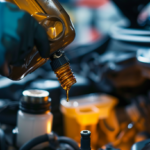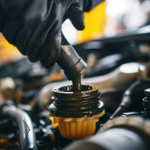Last Updated on 19 October 2023 by Lucas
Are you ready to tackle winter driving? Before hitting the road, make sure your car is prepared for the challenges ahead. In this article, we’ll guide you through the essential steps to get your vehicle winter-ready. From checking your tires and testing your battery to inspecting your brakes and ensuring proper fluid levels, we’ve got you covered. So, grab a warm drink, sit back, and let’s get your car ready for the winter roads.
Checking Your Tires
You should start by checking the tread depth and tire pressure of your car’s tires. This is crucial for winter driving as proper tire maintenance ensures optimal traction and control on icy and snowy roads. To check the tread depth, use a tread depth gauge or the good old penny test. Insert the penny into the grooves of the tire with Lincoln’s head facing down. If you can see the top of Lincoln’s head, it’s time to replace your tires. Additionally, make sure to check the tire pressure regularly and inflate them to the recommended levels. Cold temperatures cause tire pressure to drop, so it’s essential to keep them properly inflated for better handling and fuel efficiency.
Testing Your Battery
First, make sure to test your battery before the cold winter weather sets in. A weak battery can leave you stranded in the freezing temperatures, so it’s essential to check its condition. Start by inspecting the battery for any signs of corrosion or damage. If you notice any issues, it’s best to replace the battery before winter arrives. Next, use a voltmeter to measure the battery’s voltage. A fully charged battery should read around 12.6 volts or higher. If the voltage is significantly lower, it may indicate a weak battery that needs to be replaced. Additionally, consider taking your car to a professional mechanic for a load test to determine the battery’s ability to hold a charge. Taking these steps will help ensure that your battery is ready to withstand the demands of winter driving.
Inspecting Your Brakes
Check the condition of your brakes and ensure they are in proper working order before winter driving. Your brakes are one of the most important safety features of your car, especially when driving in icy or snowy conditions. Start by inspecting the brake pads for any signs of wear or damage. If they are worn down, replace them immediately. Next, check the brake fluid level and make sure it is at the recommended level. If it is low, top it up. Also, look for any leaks in the brake system. If you notice any leaks or if the brake pedal feels spongy or unresponsive, have your brakes checked by a professional mechanic. Remember, having properly functioning brakes is crucial for your safety on winter roads.
Ensuring Proper Fluid Levels
Now, let’s turn our attention to ensuring proper fluid levels in your car. It’s crucial to check the oil and coolant levels regularly to keep your engine running smoothly, especially in colder temperatures. Don’t forget to also inspect the windshield washer fluid and brake fluid to ensure they are at the appropriate levels for safe winter driving.
Oil and Coolant Checks
Make sure you have enough oil and coolant in your car to ensure proper fluid levels for winter driving. Cold temperatures can cause fluids to thicken and become less effective, so it’s essential to check and maintain them regularly. Start by checking your oil level using the dipstick. If it’s low, add the recommended oil type and quantity specified in your car’s manual. Next, check the coolant level in the radiator and the coolant reservoir. The coolant helps regulate the engine’s temperature, preventing it from freezing or overheating. Ensure the coolant level is between the minimum and maximum marks. If it’s low, add a mixture of coolant and water as recommended. By keeping an eye on your oil and coolant levels, you can ensure your car performs well during the winter months.
Windshield Washer Fluid
Have you considered how well your windshield washer fluid will perform during winter driving? It’s important to ensure that you have enough washer fluid in your car to keep your windshield clean and clear. Winter conditions can be tough on your windshield, with ice, snow, and salt all posing a threat to your visibility. By ensuring that your windshield washer fluid is at the proper level, you can ensure that you have a clear view of the road ahead. Check the level of your windshield washer fluid regularly, and top it up if necessary. It’s also a good idea to use a winter-specific washer fluid that is designed to withstand freezing temperatures. This will help to prevent your fluid from freezing and ensure that it can effectively clean your windshield during winter driving.
Brake Fluid Inspection
Check the brake fluid in your car regularly to ensure it is at the proper level for safe winter driving. Brake fluid is essential for the proper functioning of your car’s braking system. Without enough brake fluid, your brakes may not work effectively, especially in cold and icy conditions. To inspect the brake fluid levels, locate the brake fluid reservoir under the hood of your car. The reservoir usually has a minimum and maximum level indicator. Check the fluid level against these indicators and make sure it is within the recommended range. If the level is low, add the appropriate type of brake fluid to bring it up to the proper level. Remember, maintaining the correct brake fluid level is crucial for your safety on winter roads.
Updating Your Emergency Kit
Ensure that your car’s emergency kit is stocked with all the necessary supplies for winter driving. Winter weather can be unpredictable, and it’s important to be prepared for any situation that may arise on the road. Start by checking the contents of your emergency kit and make sure you have the following items: a flashlight with extra batteries, a first aid kit, a blanket or extra warm clothing, non-perishable food and water, a shovel, ice scraper, and kitty litter for traction. Additionally, include a fully charged portable phone charger, jumper cables, and a basic tool kit. It’s also a good idea to have a reflective vest, flares, and a whistle to attract attention in case of an emergency. By updating your emergency kit, you can have peace of mind knowing that you are prepared for winter driving conditions.
Preparing Your Wipers and Defrosters
Make sure your car’s wipers and defrosters are in good working condition before the winter season begins. Proper visibility is crucial when driving in winter weather conditions. Start by checking the wiper blades for any signs of wear or damage. If they are cracked or torn, replace them immediately. It’s also important to ensure that the wipers make proper contact with the windshield and effectively clear away any snow or ice. Next, test the defrosters to make sure they are working efficiently. Defrosters are essential for clearing fog or frost from the windows, providing clear visibility while driving. If you notice any issues, such as slow or weak defrosting, have it inspected and repaired as soon as possible. Taking these steps will help you maintain clear visibility and stay safe on the road during the winter months.
Protecting Your Exterior and Interior
To keep your car’s exterior and interior in optimal condition during the winter months, remember to take precautions against snow, ice, and harsh road conditions. Start by protecting the exterior of your car with a coat of wax or sealant. This will create a barrier between your car’s paint and the elements, helping to prevent rust and other damage caused by road salt and moisture. Additionally, consider investing in a car cover to shield your vehicle from snow and ice when it’s not in use. When it comes to the interior, use floor mats and seat covers to protect against dirt, moisture, and salt stains. Regularly vacuum and clean the interior to prevent the buildup of dirt and grime. Lastly, make sure to keep a snow brush, ice scraper, and windshield washer fluid in your car to deal with any winter weather surprises.

Lucas is an experienced vehicle technician with hands-on knowledge of almost every car brand available. Throughout his career, Lucas has worked on a wide range of vehicles, including domestic and foreign models, sports cars, trucks, and SUVs.





